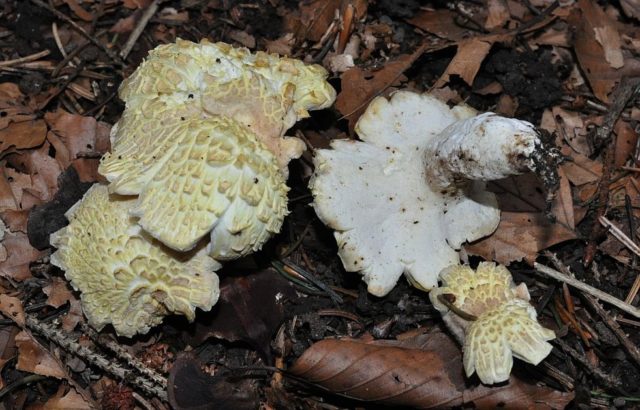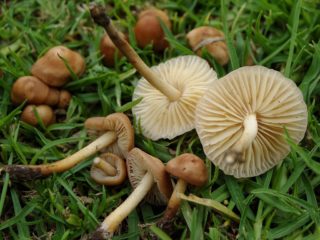Content
Albatrellus subrubescens belongs to the Albatrelaceae family and the genus Albatrellus. First described in 1940 by American mycologist William Murrill and classified as reddened scutiger. In 1965, the Czech scientist Pousar named it Albatrellus similis.
Albatrellus rubensis is closest in DNA structure to Albatrellus ovine and shares a common ancestor with it.

Unlike other types of polypores, these fruiting bodies have well-developed legs
Where does Albatrellus rouge grow?
Albatrellus blushing appears in mid-summer and continues to grow until the first frost. Loves dead, rotting wood, coniferous waste, dead wood, soil covered with small woody remains, bark and cones. Grows in compact groups, from 4-5 to 10-15 copies.
The mushroom can be found in northern Europe and its central part. In Russia, this species is rare and grows mainly in Karelia and the Leningrad region. Prefers dry pine forests.

Sometimes small groups of these mushrooms are found in mixed pine-deciduous forests
What does albatrellus blush look like?
Young mushrooms have a spherical, dome-shaped cap. As it matures, it straightens out, becoming disk-shaped, often concave, in the form of a shallow plate with the edges drooping in a rounded ridge. The shape of the cap in mature specimens is uneven, folded-lumpy, corrugated, the edges can be lace-like, cut with deep folds. There are often radial cracks.
The cap is fleshy, dry, matte, covered with large scales, rough. The color is in uneven spots, from white and yellowish-cream to the color of baked milk and ocher-brown, often with a violet tint. Overgrown mushrooms may have an uneven dirty purple or dark brown color. Diameter is from 3 to 7 cm, individual fruiting bodies grow up to 14.5 cm.
The hymenophore is tubular, strongly descending, with large angular pores. There are snow-white, cream and yellowish-light green shades. Light pink spots may appear. The pulp is dense, elastic, whitish-pink, odorless. Spore powder is creamy white.
The leg is irregularly shaped, often curved. It is located both in the center of the cap and eccentrically or to the side. The surface is dry, scaly, with thin fibers, the color matches the color of the hymenophore: white, cream, pinkish. Length from 1.8 to 8 cm, thickness up to 3 cm.

The color of the cap changes as it develops
Duplicates of the tinder fungus
Albatrellus rubensis can be confused with other members of its own species.
Sheep polypore (Albatrellus ovinus). Conditionally edible. Has greenish spots on the cap.

The mushroom is included in the list of endangered species in the Moscow region
Albatrellus syringae. Conditionally edible. The spongy spore layer does not adhere to the stalk. The pulp has a rich light yellow tint.

Concentric dark stripes may be visible on the cap
Albatrellus confluens. Conditionally edible. The fruit body is large, the caps grow up to 15 cm in diameter, smooth, without pronounced scales. The color is cream, sand-ocher.

As the pulp dries, it takes on a dirty reddish hue.
Is it possible to eat albatrellus blushing?
The fruit body is slightly poisonous; if the preparation technology is violated, it can cause stomach upset and colic. In Russia, the mushroom is classified as an inedible species due to its bitter pulp, similar in taste to aspen. In Europe, this type of tinder fungus is eaten.
Conclusion
Albatrellus blushes is a little-studied species of tinder fungus from the genus Albatrellus. It grows mainly in Europe, where it is considered an edible mushroom with a special taste. In Russia it is classified as an inedible species due to its intense bitterness, which does not go away even with heat treatment. Slightly toxic, can cause intestinal colic. Interestingly, the word “albatrellus”, which gave the name to the genus, is translated from Italian as “boletus” or “boletus”.








